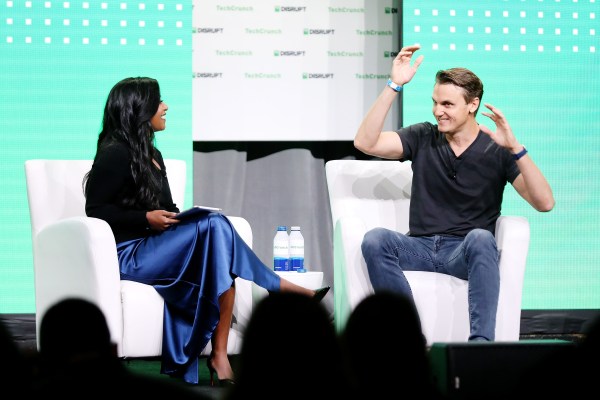For most venture-backed social companies, a period of hypergrowth seems like it would be the dream. It means the app broke through the noise of thousands of others, resonated with a mass market of people and didn’t need to spend a penny on marketing.
Clubhouse, however, offered a retort to that perspective. The app’s fall from peak, both in terms of daily active users and general fanfare among techies, has been intriguing after its splashy invite-only start. Paul Davison, Clubhouse co-founder and CEO, spoke about changes at the company at TechCrunch Disrupt last week.
“We had a couple of months of insane, silly, unsustainable 10x month-over-month growth,” Davison said. “I think what people might not appreciate is that Clubhouse has kind of moved into all of these different verticals, and they probably don’t appreciate the size of the community and the activity and the diversity and the range and all the conversations that are happening.”
He added: “I don’t think hype is good, I don’t think extreme hypergrowth is good for a company. The ideal is to grow at a steady pace.”
Let’s not hype up hype
Davison described Clubhouse’s “hype moment,” during which the app grew users 10x month over month and took the No. 1 spot at the App Store in Japan, Hong Kong, Russia, Germany, Brazil and Italy.
While the company was able to use that momentum to raise over $100 million in financing, with its latest known round closing in April 2021, Davison grounded the narrative. The co-founder said that the 10x growth lasted two months and spiked the app’s Sensor Tower metrics, which “shaped the narrative” when downloads began to slow down.
In reality, the hype stressed the infrastructure, Davison admitted.
“You have to scale really, really quickly just to keep the service up, because everything is breaking; you’re getting read error messages everywhere, people try to come up on stage to talk and it takes 10 minutes for a notification [ … ] back then we didn’t even have language filtering.”
“A lot of people who joined during that period are going to be joining just because they heard about it,” Davison said. “And they had a really bad experience when they joined because everything was broken, nothing works, for months after that you have people joining and the relevance of their hallway is hurt and they can’t find good rooms.”
If Clubhouse didn’t fuel the hype, what did? Davison noted that, at the time, they didn’t respond to press inquiries — which would’ve cleared up some of the mystique — because he and his co-founder were heads-down building.
Davison also said that they never asked celebrities to join the app in its early days. That said, the app certainly benefited from the fact that users felt like they had the chance of virtually running into a Kevin Hart or a Tiffany Haddish. Davison said that reports that Andreessen Horowitz won the term-sheet sweepstakes because they got Hart on the app were “silly.”
Now that the world is opening up, some could argue that the very existence of IRL interaction is a threat to social audio. It comes down to a quintessential 2022 question: In this mushy new normal, do you prefer remote chat, or would you rather meet in person now that it is a viable option?
Davison’s retort is that the world opening up will create a “more acute need” to have a place to have conversations, and Clubhouse is a hands-free experience to do so.
“It’s designed so you can multitask,” Davison said. “And what we’ve seen is a lot more people using the Clubhouse when they’re driving, when they’re at the gym, when they’re at the market, when they’re at work; 25% of our users use it in the shower.” (An interesting fact that they landed on through an in-app user survey.)
Broadcast versus private
The co-founder said that a “much bigger” part of the app these days is private rooms like those mentioned above, instead of celebrity-led and publicly broadcasted rooms that Clubhouse was associated with in its early days.
“The trends we’re building toward are permanent,” he said, of Clubhouse’s new focused user base. Davison declined to share how many daily active users Clubhouse has or any growth figures, but he did say that “millions of people” made their way through Clubhouse amid the height of the app.
Even so, it’s not like other apps have not come from Clubhouse’s lunch. Twitter, its most formidable competitor through its launch of Twitter Spaces, reportedly tried to acquire Clubhouse last April for $4 billion. When asked about the acquisition rumors, Davison said he “can’t comment on any conversations about anything.”
Now that it’s a competitor, Davison said that “focus is really important” and that Clubhouse has the upper edge because it is fully focused on the social audio medium instead of other behemoths offering social audio as one of many services.
“Twitter is a broadcast product and I think what they’re building is something that is targeting broadcast,” he said. “Clubhouse at its core is about participation in conversations and friendship [ … ] and having these off-the-record conversations and sharing ideas and learning. And I think it’s a very different use case.”
“If you look at history [ … ] when there’s a new medium, the winner historically has been a company that is fully focused on that medium,” he said. “If it’s not the company’s sole reason for being, they tend to deprioritize it when times get hard for them. And we’ve already seen a number of these competitors that you’re talking about deprioritize their efforts here.”
He added: “We’ll see if I’m right, but that’s what we believe.”
